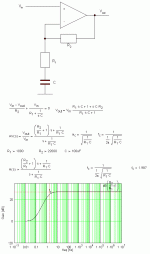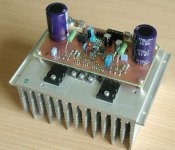I've build the Leach amp. As a matter of fact, it was my first project. The only reason I ever finished it is that I am very stubborn. Took me quite some time, since I was not very experienced with electronics on that level when I started.
But, after some disasterous problems (first try started burning in my living room floor), I learned how to troubleshoot the darn thing and got it up and running.
My advice is, try and build both. Leach amp requires quite some work, not only in building. The parts are quite hard to find in some parts of the world.
P3A must be easier to build. Try it, then build the Leach.
My 2 cents,
//magnus
But, after some disasterous problems (first try started burning in my living room floor), I learned how to troubleshoot the darn thing and got it up and running.
My advice is, try and build both. Leach amp requires quite some work, not only in building. The parts are quite hard to find in some parts of the world.
P3A must be easier to build. Try it, then build the Leach.
My 2 cents,
//magnus
pooge,
I'm not sure your comments are quite correct. If the C6 'other half' is not jumpered then the bottom leg of the feedback network will not be connected to anything, so the amp will be running at unity gain across the whole bandwidth right down to DC.
This would be very noticeable because the sound would be very quiet , but bass reproduction would not be hampered at all because of the flat response down to DC.
I'm not sure your comments are quite correct. If the C6 'other half' is not jumpered then the bottom leg of the feedback network will not be connected to anything, so the amp will be running at unity gain across the whole bandwidth right down to DC.
This would be very noticeable because the sound would be very quiet , but bass reproduction would not be hampered at all because of the flat response down to DC.
Thanks guys!
I care more about the sound quality than the complexity...
I think those TO-5 signal transistors in Leach are really hard to be sourced....
Any other comments?
P.S: JensRasmussen, how did your amps sound different to each other? Have you built any other amps that could be compared with?
I care more about the sound quality than the complexity...

I think those TO-5 signal transistors in Leach are really hard to be sourced....

Any other comments?
P.S: JensRasmussen, how did your amps sound different to each other? Have you built any other amps that could be compared with?
"I care more about the sound quality than the complexity...
I think those TO-5 signal transistors in Leach are really hard to be sourced...."
There is nothing special about any of the transistors used in the Leach.
They are common industrial types.
The TO5 types are made by many companies, and probably will still be available for years to come.
http://www.crystalonics.com/powertransistors1.htm
http://www.solitrondevices.com/about.htm
http://power.st.com/stonline/products/support/space/power.htm
http://ssdi-power.com/catalog.asp?product_subtype_id=21
http://www.magnatec-uk.com/semlst.shtml
http://www.centralsemi.com/
Mouser sells both ST and CS for about $0.68 in one-lot-qty
If you lay out your boards with a fourth hole in line then you can also use the TO220 or TO126 case styles as well as the TO5.
I think those TO-5 signal transistors in Leach are really hard to be sourced...."
There is nothing special about any of the transistors used in the Leach.
They are common industrial types.
The TO5 types are made by many companies, and probably will still be available for years to come.
http://www.crystalonics.com/powertransistors1.htm
http://www.solitrondevices.com/about.htm
http://power.st.com/stonline/products/support/space/power.htm
http://ssdi-power.com/catalog.asp?product_subtype_id=21
http://www.magnatec-uk.com/semlst.shtml
http://www.centralsemi.com/
Mouser sells both ST and CS for about $0.68 in one-lot-qty
If you lay out your boards with a fourth hole in line then you can also use the TO220 or TO126 case styles as well as the TO5.
richie00boy said:pooge,
I'm not sure your comments are quite correct. If the C6 'other half' is not jumpered then the bottom leg of the feedback network will not be connected to anything, so the amp will be running at unity gain across the whole bandwidth right down to DC.
This would be very noticeable because the sound would be very quiet , but bass reproduction would not be hampered at all because of the flat response down to DC.
The cap bypass cap C7 probably contributes. From Leach:
"C6 is an electrolytic capacitor. C7 is a film capacitor which is used in parallel with C6 to improve its high-frequency characteristics. The circuit board layout provides an option to use two polar capacitors in series for C6 or a single non-polar capacitor. If a non-polar capacitor is used, a short circuit jumper must be installed to complete the circuit. One builder who accidentally left the jumper off was distressed because his amplifier had very poor bass response. Without the jumper, the lower cutoff frequency is 1.4 kHz rather than below 1 Hz."
richie00boy said:OK
I think the error would be blindly obvious though, not just the more subtle poor bass that some on here seem to be implying.
You would think. But the way some have written here and in other threads, it is more than subtle. Variations in power supplies are a likely difference, also. This would probably be the biggest variation among DIY samples. Single vs. dual, for example. Others don't report poor bass.
swede said:
My advice is, try and build both. Leach amp requires quite some work, not only in building. The parts are quite hard to find in some parts of the world.
I have the MPS8599 transistors from On-Semi -- they are on "reel", email me if interested.
jamesjung21 said:P.S: JensRasmussen, how did your amps sound different to each other? Have you built any other amps that could be compared with?
I like the Leach best. It has more power, and seems more relaxed
However, the P3A is great also, if I ever need a small amp again, I'll build this one
\Jens
Attachments
- Status
- This old topic is closed. If you want to reopen this topic, contact a moderator using the "Report Post" button.
- Home
- Amplifiers
- Solid State
- P3A Vs Leach

